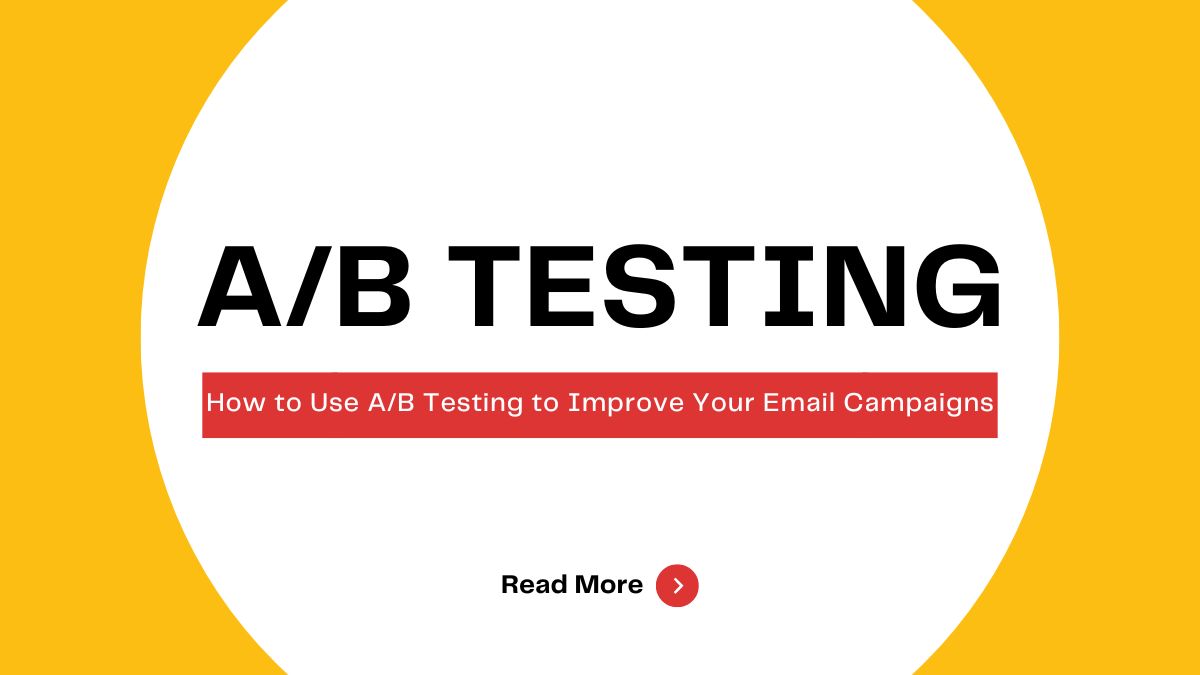
Email marketing is a top way to engage your audience. It drives conversions and builds brand loyalty. However, not every email campaign is a guaranteed success. To maximize your email marketing, you must test and optimize your campaigns. One of the most powerful methods for achieving this is A/B testing.
This guide will explore A/B testing. We’ll cover how to use it for your email campaigns, and best practices for success.
What is A/B Testing?
A/B testing, also known as split testing, is a method of comparing two versions of an email to determine which one performs better. This process involves sending one version (Version A) to a segment of your audience. Then, send a slightly modified version (Version B) to another segment. Analyzing the results will show which version is more effective. This is if your goal is to improve open rates, CTR, or conversions.
Why is A/B Testing Important for Email Campaigns?
A/B testing is a critical component of any email marketing strategy for several reasons:
Improves Engagement: By testing different elements, you can identify what resonates best with your audience, leading to higher open and click-through rates.
Increases Conversions: Testing helps you understand what drives recipients to take action, such as clicking a link or making a purchase.
Reduces Guesswork: Instead of relying on assumptions or gut feelings, A/B testing provides data-driven insights to guide your email marketing decisions.
Optimizes ROI: By fine-tuning your campaigns based on test results, you can achieve better results with your existing budget, leading to a higher return on investment (ROI).
What Elements Should You A/B Test in Your Email Campaigns?
To improve your email campaigns through A/B testing, you must test various elements. They can affect your emails’ effectiveness. Here are some of the most important components to consider:
1. Subject Lines
The subject line is often the first impression of your email. It is key to whether recipients will open it. You can test:
Length: Short vs. long subject lines
Tone: Formal vs. casual
Inclusion of Numbers: “Save 50%” vs. “Big Sale”
Questions vs. Statements: “Need a holiday?” vs. “Holiday deals inside”
Personalization: Using the recipient’s name vs. a generic greeting
2. Email Content
Testing the body of your email can provide insights into what keeps your audience engaged. Consider testing:
Content Length: Short and concise vs. long and detailed emails
Text vs. Images: Text-heavy emails vs. emails with more visuals
Tone and Style: Formal vs. conversational language
Storytelling: Emails that tell a story vs. straightforward offers
3. Call-to-Action (CTA)
Your CTA is the driving force behind conversions. Experiment with:
Button vs. Text Links: Using a clickable button vs. a hyperlinked text
CTA Wording: “Shop Now” vs. “Get Started” vs. “Learn More”
CTA Placement: Above the fold vs. at the end of the email
CTA Color: Testing different colors to see which one grabs attention
4. Images and Visuals
Visual elements can make or break your email campaign. Test:
Different Images: People vs. product images
Image Placement: Top of the email vs. within the content
Animated GIFs: Static images vs. animated visuals
5. Sender Name
The name that appears in the “From” field can impact open rates. Try testing:
Brand Name: Using your company name vs. an individual’s name
Personalization: A combination of a person’s name and brand (e.g., “Sarah from BrandX”)
6. Send Time and Day
The timing of your email can significantly affect engagement. Experiment with:
Different Days: Weekdays vs. weekends
Time of Day: Morning vs. afternoon vs. evening
How to Conduct A/B Testing for Your Email Campaigns
A/B testing can seem complex, but following a systematic approach will help you gain meaningful insights. Here’s a step-by-step guide:
Step 1: Define Your Goal
Before starting any test, it’s essential to identify what you want to achieve. Are you looking to improve your open rate, CTR, conversion rate, or something else? Having a clear goal will help you focus your testing efforts and measure success more effectively.
Step 2: Choose the Element to Test
As tempting as it might be to test multiple elements at once, it’s best to focus on one variable per test. This ensures that you can accurately attribute any changes in performance to the specific element being tested.
Step 3: Create Your Variations
Create two versions of your email, with only one element being different. For example, if you’re testing subject lines, Version A might be “Get 50% Off Today,” while Version B is “Huge Savings: 50% Off!”
Step 4: Determine Your Sample Size
To ensure statistically significant results, it’s essential to test with a large enough sample size. Most email marketing platforms, like Mailchimp and Constant Contact, can automatically determine the ideal sample size based on your list size.
Step 5: Launch the Test
Send the two variations to your chosen sample groups. Allow enough time for recipients to interact with your email before drawing any conclusions—typically, 24 to 48 hours is sufficient.
Step 6: Analyze the Results
Examine the performance of both variations based on your predefined goal. Most email marketing platforms will provide data such as open rates, click-through rates, and conversion rates to help you determine the winning version.
Step 7: Implement the Winning Version
Once you’ve identified the better-performing variation, send the winning email to the rest of your list. Keep track of its performance and make further optimizations as needed.
Step 8: Repeat the Process
A/B testing is not a one-time activity. To improve your email campaigns, test different elements. Then, iterate based on the results.
Best Practices for Effective A/B Testing
To get the most out of your A/B testing efforts, keep the following best practices in mind:
1. Test One Element at a Time
Testing multiple elements simultaneously can make it difficult to pinpoint which change led to the results. Focus on one element per test for accurate insights.
2. Allow Sufficient Testing Time
Ensure you give your audience enough time to interact with the email before drawing any conclusions. This will help you capture a more accurate representation of your audience’s behavior.
3. Use a Large Enough Sample Size
A small sample size may lead to inconclusive or misleading results. Use a significant portion of your email list to achieve statistically valid results.
4. Document Your Findings
Keep a record of your A/B tests, including what you tested, the results, and any insights gained. This will help you build a repository of knowledge to inform future campaigns.
5. Test Regularly
Consumer preferences and behaviors can change over time. Regularly testing different elements ensures that your email campaigns stay optimized and effective.
6. Test on Mobile Devices
A large percentage of email recipients open emails on mobile devices. Make sure your emails are optimized for both desktop and mobile to avoid missing out on potential engagement.
Common Mistakes to Avoid in A/B Testing
Making Changes Based on Inconclusive Data: It’s easy to get excited and draw conclusions too quickly. Make sure you wait for statistically significant results before implementing changes.
Ignoring Segmentation: Different segments of your audience may respond differently. Ensure you’re testing with relevant segments to gain insights that apply to the specific group.
Focusing Only on Short-Term Results: While a change might show immediate improvements, it’s essential to monitor its long-term impact to ensure sustained performance.
Tools for A/B Testing Your Email Campaigns
Several email marketing platforms offer built-in A/B testing capabilities, including:
Mailchimp: Provides A/B testing for subject lines, content, and send times.
Constant Contact: Offers split testing options for subject lines and email content.
ActiveCampaign: Allows A/B testing of multiple email elements, including subject lines, content, and CTAs.
HubSpot: Features advanced A/B testing capabilities, with the option to test up to five variations at once.
Conclusion
A/B testing is a powerful tool. It can help you improve your email campaigns, boost engagement, and increase conversions. You can improve your email marketing by testing different elements. Then, use data to make changes. This will boost your results over time.
Remember, A/B testing is an ongoing process. As your audience evolves, their preferences will change, and what works today might not work tomorrow. Test, analyze, and optimize your emails. This will keep them effective, relevant, and profitable.
Start implementing A/B testing today, and watch your email marketing efforts reach new heights!




